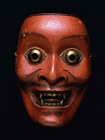Japanese Gallery (Honkan) Room 9
May 18, 2010 (Tue) - July 4, 2010 (Sun)
In the world of Noh, ideal performance styles for lead roles are known as "fushi." The classical Noh treatise Nikyoku Santai Ningyo Zu describes the fushi for a variety of lead roles as specified by Zeami, the author of the treatise and the father of Noh as it exists today.
For demon roles, Zeami lists two main fushi. The first, the Saido style, evokes a character "with the appearance of a demon, but the soul of a human." Performed with "subtle movements and a relaxed body and mind," this style forms the basis for all fushi in Noh. The second style, Rikido, is a "rugged" style used to depict "demons in both appearance and nature." Whilst the Rikido style may be "less appealing than other styles," Zeami notes that "it can nonetheless captivate the audience and draw a play to its climax with an enchanting overlay of dancing and chants."
These concepts became the foundation for the characterization of demons in Noh. Even the fiercest-looking demons and spirits express the ideals of Zeami, who envisioned the Noh stage as a mystical realm.
Another treatise by Zeami, entitled Sarugaku Dangi, lists specific names for the masks used in demon-themed plays, indicating that Noh's traditional repertoire of demon masks was already in existence during the Muromachi period (1392-1573). The masks themselves can be seen as visually representative of Noh in its earliest stages.
How were the characters of fearsome gods, animal spirits and goblins realized upon the Noh stage? The masks and costumes in this exhibition convey the mysticism of Noh's demon characters, which provide insight into the medieval Japanese imagination.

